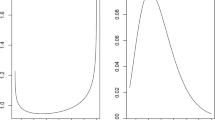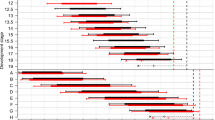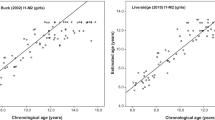Abstract
When an estimate of age is needed, typically multiple indicators are present as found in skeletal or dental information. There exists a vast literature on approaches to estimate age from such multivariate data. Application of Bayes’ rule has been proposed to overcome drawbacks of classical regression models but becomes less trivial as soon as the number of indicators increases. Each of the age indicators can lead to a different point estimate (“the most plausible value for age”) and a prediction interval (“the range of possible values”). The major challenge in the combination of multiple indicators is not the calculation of a combined point estimate for age but the construction of an appropriate prediction interval. Ignoring the correlation between the age indicators results in intervals being too small. Boldsen et al. (2002) presented an ad-hoc procedure to construct an approximate confidence interval without the need to model the multivariate correlation structure between the indicators. The aim of the present paper is to bring under attention this pragmatic approach and to evaluate its performance in a practical setting. This is all the more needed since recent publications ignore the need for interval estimation. To illustrate and evaluate the method, Köhler et al. (1995) third molar scores are used to estimate the age in a dataset of 3200 male subjects in the juvenile age range.




Similar content being viewed by others
Notes
() To appreciate the flavor of the rationale, consider the probability density function (pdf) of a standard normal variable X. The distribution has its maximum in 0 where the pdf is equal to 0.398942 (in Excel, the pdf can be obtained by using the function NORM.DIST(0;0;1;0)). Let us obtain the pdf in another arbitrarily chosen value, say X = 1.5, equals 0.129518. The square root of the absolute value of 2 times the natural logarithm of the ratio of both pdf values then equals 1.5.
References
Gunst K, Mesotten K, Carbonez A, Willems G (2003) Third molar root development in relation to chronological age: a large sample sized retrospective study. Forensic Sci Int 136:52–57
Aykroyd R, Lucy D, Pollard A, Roberts C (1999) Nasty, brutish, but not necessarily short: a reconsideration of the statistical methods used to calculate age at death from adult human skeletal and dental indicators. Am Antiq 64:55–70
Lucy D, Aykroyd RG, Pollard AM (2002) Non-parametric calibration for age estimation. Appl Stat 52:185–196
Thevissen PW, Fieuws S, Willems G (2010) Human dental age estimation using third molar developmental stages: does a Bayesian approach outperform regression models to discriminate between juveniles and adults? Int J Legal Med 124:35–42
Aykroyd RG, Lucy D, Pollard AM, Solheim T (1997) Technical note: regression analysis in adult age estimation. Am J Phys Anthropol 104:259–265
Hoppa RD, Vaupel JW (2002) Paleodemography. Age distributions from skeletal samples. Cambridge University Press, Cambridge
Samworth R, Gowland R (2007) Estimation of adult skeletal age-at-death: statistical assumptions and applications. Int J Osteoarchaeol 17:174–188
Calce S, Rogers T (2011) Evaluation of age estimation technique: testing traits of the acetabulum to estimate age at death in adult males. J Forensic Sci 56(302):311
Schmeling A, Olze A, Reisinger W, Geserick G (2001) Age estimation of living people undergoing criminal proceedings. 23001 (Lancet)
Schmeling A, Grundmann C, Fuhrmann A, Kaatsch H, Knell B, Ramsthaler F et al (2008) Criteria for age estimation in living individuals. Int J Legal Med 122(6):457–460
Cole TJ (2008) Hot potato topic [letter to the editor]. Br Dent J 205:581–582
Roberts GJ, Parekh S, Petrie A, Lucas VS (2008) Dental age assessment (DAA): a simple method for children and emerging adults. Br Dent J 204(4):E7
Boldsen JL, Milner GR, Konigsberg LW, Wood JW (2002) Transition analysis: a new method for estimating age from skeletons. In: Hoppa RD, Vaupel JW (eds) Paleodemography: age distributions from skeletal samples. Cambridge University Press, Cambridge, pp 73–106
Thevissen PW (2013) Dental age estimation in sub-adults: striving for an optimal approach. Leuven University Press, Leuven
Köhler S, Schmelzl RL, Püschel K (1994) Development of wisdom teeth as a criterion of age determination. Ann Anat 176:339–345
Cole TJ (1990) The LMS method for constructing normalized growth standards. Eur J Clin Nutr 44(1):45–60
Aykroyd R, Lucy D, Pollard A, Solheim T (1997) Technical note: regression analysis in adult age estimation. Am J Phys Anthropol 104:259–265
Harrell F (2001) Regression modeling strategies. Springer, New-York
Agresti A (1990) Categorical data analysis. Wiley, New York
Liang KY, Zeger SL (1986) Longitudinal data analysis using generalized linear models. Biometrika 73:13–22
Cox DR, Hinkley DV (1974) Theoretical statistics. Chapman & Hall, London
DiGangi EA, Bethard JD, Kimmerle EH, Konigsberg LW (2009) A new method for estimating age-at-death from the first rib. Am J Phys Anthropol 138:164–176
Kimmerle EH, Konigsberg LW, Jantz RL, Baraybar JP (2008) Analysis of age-at-death through the use of pubic symphyseal data. J Forensic Sci 53:558–568
Milner GR, Boldsen JL (2012) Transition analysis: a validation study with known-age modern American skeletons. Am J Phys Anthropol 148:98–110
Roberts GJ, McDonald F, Neil M, Lucas VM (2014) The weighted average method “WAM” for dental age estimation: a simpler method for children at the 10 year threshold. J Forensic Leg Med 26:56–60
Fieuws S, Willems G, Thevissen P (2015) Letter to the Editor regarding the article by Roberts, et al. published in volume 26, August 2014 Journal of Forensic and Legal Medicine. J Forensic Leg Med 29:24
Author information
Authors and Affiliations
Corresponding author
Addendum
Addendum
Summary of to estimate age for subject with ordinal scores Y i = Yi1, Yi2, Yi3, Yi4
-
Step 1: Fit for each of the four ordinal scores (Y1, Y2, Y3, Y4) separately a continuation-ratio model in the training dataset.
-
Step 2: Assuming a uniform prior distribution the age range 15 to 23 years, the posterior is proportional to the conditional distribution f(age|Yi) ∝ P(Yi|age). Assume conditional independence to calculate the multivariate distribution P(Yi1, Yi2, Yi3, Yi4|age)
$$ P\left({\mathrm{Y}}_{\mathrm{i}1},{\mathrm{Y}}_{\mathrm{i}2},{\mathrm{Y}}_{\mathrm{i}3},{\mathrm{Y}}_{\mathrm{i}4}\Big|\mathrm{age}\right)=P\left({\mathrm{Y}}_{\mathrm{i}1}\Big|\mathrm{age}\right)\times P\left({\mathrm{Y}}_{\mathrm{i}2}\Big|\mathrm{age}\right)\times P\left({\mathrm{Y}}_{\mathrm{i}3}\Big|\mathrm{age}\right)\times P\left({\mathrm{Y}}_{\mathrm{i}4}\Big|\mathrm{age}\right) $$-
Obtain the point estimate ageML as the value of age maximizing this function.
-
Normalize this distribution to interpret a surface as a probability and to visualize the posteriors corresponding to different score patterns.
-
Obtain a (1-α)100 % PI as the (1-α)100 % values with the highest function value and/or obtain the API by applying expression (2).
-
The quantiles from the posterior (and thus also the PI and the API) are only valid if the conditional independence assumption holds.
-
-
Step 3: In the training dataset, calculate the variance of the \( {z}_i=\pm \sqrt{\left|2 \ln \left({\mathrm{LR}}_i\right)\right|} \), with LR i = f(age i |Y i )/f(age ML i |Y i ). Values of the variance higher than 1 refer to a violation of the conditional independence assumption.
-
Step 4: Obtain the APIC for a specific pattern of four ordinal scores
-
In expression (2) replace f(age i |Y i )/f(age ML i |Y i ) by \( {\left[f\left(\mathrm{age}\Big|{Y}_i\right)/f\left({\mathrm{age}}^{\mathrm{ML}}\Big|{Y}_i\right)\right]}^{1/var\left({z}_i\right)} \). The 95 % APIC is given by the range of all values of age for which the adapted expression (2) is smaller than or equal to 3.84.
-
Evaluate the cumulative distribution function of the standard normal at \( {z}_i=\pm \sqrt{\left|2 \ln \left({\mathrm{LR}}_i\right)\right|} \) with \( L{R}_i={\left[f\left(\mathrm{age}=b\Big|{Y}_i\right)/f\left({\mathrm{age}}^{\mathrm{ML}}\Big|{Y}_i\right)\right]}^{1/var\left({z}_i\right)} \) to obtain the probability that a subject with scores Yi is younger than b years
-
-
Step 5: Assure that the posterior distribution of age for a specific combination of scores Yi can be interpreted as a probability density function in the age range considered, and calculate the APICn.
-
Calculate at each age \( {z}_i=\pm \sqrt{\left|2 \ln \left({\mathrm{LR}}_i\right)\right|} \), with \( L{R}_i={\left[f\left(\mathrm{age}\Big|{Y}_i\right)/f\left({\mathrm{age}}^{\mathrm{ML}}\Big|{Y}_i\right)\right]}^{1/var\left({z}_i\right)} \) instead of LR i = f(age i |Y i )/f(age ML i |Y i ) and its corresponding probability density.
-
Normalize the probability density values such that the total surface in the considered age range equals one.
-
Using the normalized values, calculate an alternative CI based on the (1-α)100 % values with the highest function value (APICn) and derive probabilities to be younger than a specific age
-
Rights and permissions
About this article
Cite this article
Fieuws, S., Willems, G., Larsen-Tangmose, S. et al. Obtaining appropriate interval estimates for age when multiple indicators are used: evaluation of an ad-hoc procedure. Int J Legal Med 130, 489–499 (2016). https://doi.org/10.1007/s00414-015-1200-8
Received:
Accepted:
Published:
Issue Date:
DOI: https://doi.org/10.1007/s00414-015-1200-8




